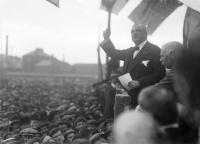countdown to 2016: Home Rule rally on Sackville Street, March 1912 by Joseph E.A. Connell Jr
Published in 20th-century / Contemporary History, Home Rule, Issue 2(March/April 2012), Reviews, Volume 20
John Redmond addressing the ‘monster meeting’ in support of the Home Rule bill on Sackville (O’Connell) Street on 31 March 1912. Eoin MacNeill and Patrick Pearse also spoke. (National Library of Ireland)
At the end of the nineteenth century most efforts at improving the lot of the Irish were constitutional, led by Charles Stewart Parnell. Parnell believed that solving the land question would be the first step on the road to Home Rule. For almost half a century—from the early 1870s to the end of the First World War—Home Rule was both the single most dominant feature of Irish political life and a major influence within British politics. In December 1882, when the Irish National League replaced the suppressed Land League, Parnell ensured that the new organisation was under the control of his Irish Parliamentary Party (IPP) and that its primary objective was the winning of Home Rule for Ireland. William Gladstone, several times Liberal prime minister of the United Kingdom in the latter half of the nineteenth century, in order to gain IPP backing in parliament, from 1886 gave the Home Rule movement his support. For Gladstone, Home Rule was a means to reconcile Irish nationalism with the British union. For others, such as the Conservative Party, and especially the Ulster Unionists, Home Rule represented the thin end of the wedge, and their opposition to it was so complete that a civil war threatened in Ireland. Following Parnell’s downfall, John Redmond eventually reunited the IPP under his leadership in 1900. The much-reduced majority of the Liberals in two general elections in 1910, following their landslide victory in 1906, made them dependent once again on the support of the IPP and put Home Rule back on the agenda. The 1911 Parliament Act effectively ended the power of the Conservative-dominated House of Lords to veto legislation passed by the House of Commons: now the Lords could only delay it. In 1912 a third Home Rule bill was introduced. On 31 March 1912, there was a ‘monster meeting’ in Sackville Street (now O’Connell Street) to support the bill. The first speaker was John Redmond: ‘Trust the old party and Home Rule next year’. The second speaker was Eoin MacNeill: ‘There is no government so very bad that it would not be better for the Irish people to accept it if they themselves were in charge of it’. Patrick Pearse spoke third. Like MacNeill, Pearse spoke in Irish:
‘We have no wish to destroy the British, we only want our freedom. We differ among ourselves on small points, but we agree that we want freedom, in some shape or other . . . But I should think myself a traitor to my country if I did not answer the summons of this gathering, for it is clear to me that the bill we support today will be for the good of Ireland, and that we will be stronger with it than without it. Let us unite and win a good Act from the British: I think it can be done.’
He concluded with the following words, however:
‘If we are tricked this time, there is a party in Ireland, and I am one of them, that will advise the Gael to have no counsel or dealing with the Gall but to answer henceforward with the strong arm and the sword’s edge . . . If we are cheated once more there will be red war in Ireland.’
In the early years, Pearse’s nationalism was more cultural than political, but later he came to the conclusion that force was needed in the face of Ulster Unionist opposition to Home Rule. Just four years later he would read the Proclamation of the Irish Republic from the steps of the GPO on the same street. HI
Joseph E.A. Connell is the author of Dublin in rebellion: a directory, 1913–1923 (Lilliput Press, 2006).
Further reading:
R.E. Childers, The framework of Home Rule (London, 1911).A. O’Day, Irish Home Rule, 1867–1921 (Manchester, 1998).A.T.Q. Stewart, The Ulster Crisis: resistance to Home Rule, 1912–14 (London, 1967).
















